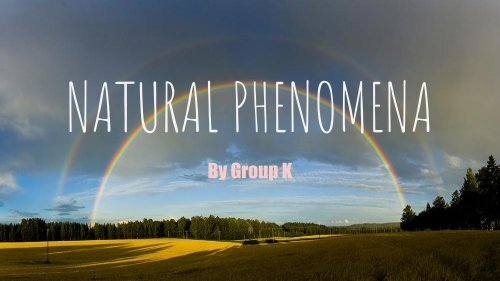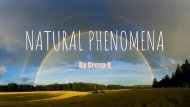Create successful ePaper yourself
Turn your PDF publications into a flip-book with our unique Google optimized e-Paper software.
NATURAL PHENOMENA<br />
By Group K
Solar Eclipse<br />
Occurs when<br />
an observer<br />
(on Earth)<br />
passes<br />
through the<br />
shadow cast<br />
by the Moon<br />
which fully or<br />
partially<br />
blocks the<br />
Sun<br />
●<br />
●<br />
●<br />
A solar eclipse<br />
occurs when the<br />
moon gets<br />
between Earth<br />
and the sun.<br />
The moon casts a<br />
shadow over<br />
Earth.<br />
A solar eclipse<br />
can only take<br />
place at the<br />
phase of new<br />
moon, when the<br />
moon passes<br />
directly between<br />
the sun and Earth<br />
and its shadows<br />
fall upon Earth's<br />
surface.
Tornado<br />
a violently rotating column of air<br />
that extends from a thunderstorm<br />
to the ground<br />
It's often portended by a dark,<br />
greenish sky. Black storm clouds<br />
gather.<br />
reported in Great Britain, India, Argentina, and<br />
other countries, but most tornadoes occur in<br />
the United States.<br />
Tornados come from thunderstorms<br />
and they can occur whenever and<br />
wherever conditions are right<br />
form when warm, humid air collides with<br />
cold, dry air. When these two air masses meet,<br />
they create instability in the atmosphere.
THUNDER<br />
Sound caused by lightning.<br />
Depending on the distance from and<br />
nature of the lightning.<br />
Sharp, loud crack to a long, low rumble<br />
(brontide).<br />
Expansion of air creates a sonic shock<br />
wave, similar to a sonic boom, often<br />
referred to as a "thunderclap" or "peal of<br />
thunder".<br />
Early speculation was that it was caused<br />
by the collision of clouds.<br />
Sudden increase in pressure and<br />
temperature from lightning produces<br />
rapid expansion of the air surrounding<br />
and within a bolt of lightning.<br />
The accepted theory was that lightning<br />
produced a vacuum.
SNOW<br />
Partially frozen water vapor which<br />
falls in flakes<br />
Formed when temperature is low<br />
and the moisture is high<br />
Falls during winter<br />
When the air temperature is below freezing,<br />
water vapour that would normally condense<br />
into cloud droplets will change directly into<br />
ice without ever becoming a liquid, forming<br />
around tiny particles in the air, such as a grain<br />
of sand or soot.<br />
Usually happens in regions outside<br />
the equator line of the Earth
References<br />
●<br />
●<br />
●<br />
●<br />
●<br />
●<br />
●<br />
https://www.weatherwizkids.com/weather-tornado.htm<br />
https://www.nationalgeographic.com/environment/natural-disasters/tornadoes/<br />
http://scienceline.ucsb.edu/getkey.php?key=3813<br />
http://weatherstreet.com/weatherquestions/What_causes_tornadoes.htm<br />
https://nsidc.org/cryosphere/snow<br />
https://www.youtube.com/watch?v=Cf6El0mI1fM&t=26s<br />
https://www.space.com/15584-solar-eclipses.html




